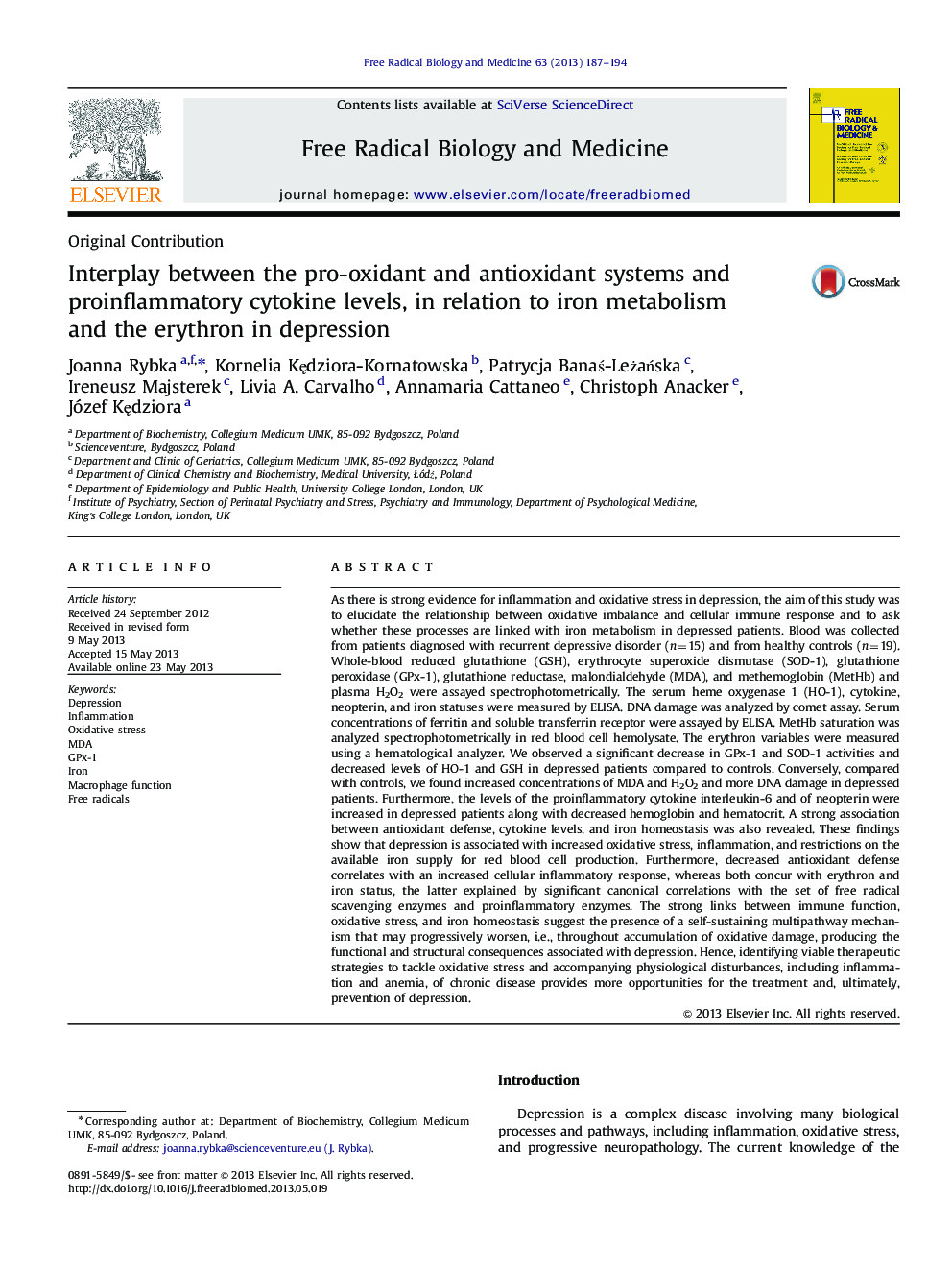| کد مقاله | کد نشریه | سال انتشار | مقاله انگلیسی | نسخه تمام متن |
|---|---|---|---|---|
| 8270979 | 1534979 | 2013 | 8 صفحه PDF | دانلود رایگان |
عنوان انگلیسی مقاله ISI
Interplay between the pro-oxidant and antioxidant systems and proinflammatory cytokine levels, in relation to iron metabolism and the erythron in depression
ترجمه فارسی عنوان
تعامل بین سیستم های پروتئین اکسیدان و آنتی اکسیدان و سطوح سیتوکین ضد التهابی در ارتباط با متابولیسم آهن و اریترون در افسردگی
دانلود مقاله + سفارش ترجمه
دانلود مقاله ISI انگلیسی
رایگان برای ایرانیان
کلمات کلیدی
موضوعات مرتبط
علوم زیستی و بیوفناوری
بیوشیمی، ژنتیک و زیست شناسی مولکولی
سالمندی
چکیده انگلیسی
As there is strong evidence for inflammation and oxidative stress in depression, the aim of this study was to elucidate the relationship between oxidative imbalance and cellular immune response and to ask whether these processes are linked with iron metabolism in depressed patients. Blood was collected from patients diagnosed with recurrent depressive disorder (n=15) and from healthy controls (n=19). Whole-blood reduced glutathione (GSH), erythrocyte superoxide dismutase (SOD-1), glutathione peroxidase (GPx-1), glutathione reductase, malondialdehyde (MDA), and methemoglobin (MetHb) and plasma H2O2 were assayed spectrophotometrically. The serum heme oxygenase 1 (HO-1), cytokine, neopterin, and iron statuses were measured by ELISA. DNA damage was analyzed by comet assay. Serum concentrations of ferritin and soluble transferrin receptor were assayed by ELISA. MetHb saturation was analyzed spectrophotometrically in red blood cell hemolysate. The erythron variables were measured using a hematological analyzer. We observed a significant decrease in GPx-1 and SOD-1 activities and decreased levels of HO-1 and GSH in depressed patients compared to controls. Conversely, compared with controls, we found increased concentrations of MDA and H2O2 and more DNA damage in depressed patients. Furthermore, the levels of the proinflammatory cytokine interleukin-6 and of neopterin were increased in depressed patients along with decreased hemoglobin and hematocrit. A strong association between antioxidant defense, cytokine levels, and iron homeostasis was also revealed. These findings show that depression is associated with increased oxidative stress, inflammation, and restrictions on the available iron supply for red blood cell production. Furthermore, decreased antioxidant defense correlates with an increased cellular inflammatory response, whereas both concur with erythron and iron status, the latter explained by significant canonical correlations with the set of free radical scavenging enzymes and proinflammatory enzymes. The strong links between immune function, oxidative stress, and iron homeostasis suggest the presence of a self-sustaining multipathway mechanism that may progressively worsen, i.e., throughout accumulation of oxidative damage, producing the functional and structural consequences associated with depression. Hence, identifying viable therapeutic strategies to tackle oxidative stress and accompanying physiological disturbances, including inflammation and anemia, of chronic disease provides more opportunities for the treatment and, ultimately, prevention of depression.
ناشر
Database: Elsevier - ScienceDirect (ساینس دایرکت)
Journal: Free Radical Biology and Medicine - Volume 63, October 2013, Pages 187-194
Journal: Free Radical Biology and Medicine - Volume 63, October 2013, Pages 187-194
نویسندگان
Joanna Rybka, Kornelia KÄdziora-Kornatowska, Patrycja BanaÅ-LeżaÅska, Ireneusz Majsterek, Livia A. Carvalho, Annamaria Cattaneo, Christoph Anacker, Józef KÄdziora,
